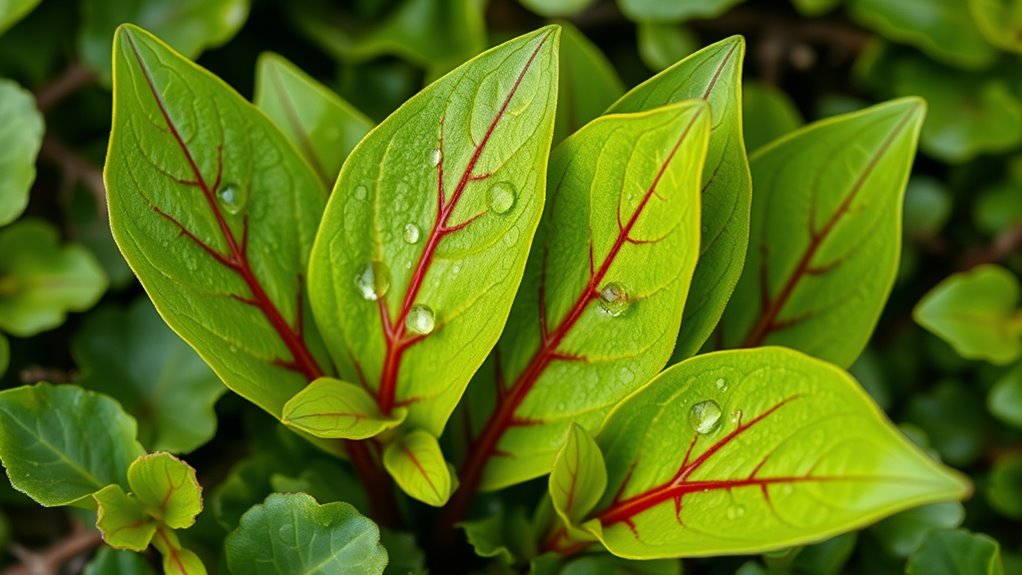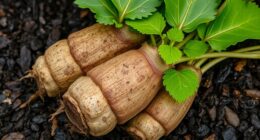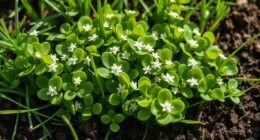To forage sheep sorrel for its tangy leaves, look in open, sunny areas like meadows or gardens with acidic, sandy soils during spring and early summer. Identify it by its arrow-shaped, green to reddish leaves and small green, yellow, or red flowers. Harvest tender leaves in the morning, avoiding mature ones or look-alikes like toxic plants. Proper identification and gentle handling guarantee safe, flavorful additions to salads; explore more ways to enjoy this versatile herb below.
Key Takeaways
- Identify sheep sorrel by its arrow-shaped, green-to-reddish leaves and small green, yellow, or red flowers in disturbed, acidic soils.
- Harvest tender leaves in spring or early summer, preferably in the morning, avoiding mature or tough foliage.
- Properly wash and dry leaves, then tear into small pieces for salads or culinary use.
- Incorporate sheep sorrel into salads, adding a tangy, lemon-like flavor to enhance freshness and nutritional value.
- Practice sustainable foraging by collecting only a small portion, verifying plant identity, and respecting local regulations and ecosystems.
Recognizing Sheep Sorrel in Its Natural Habitat
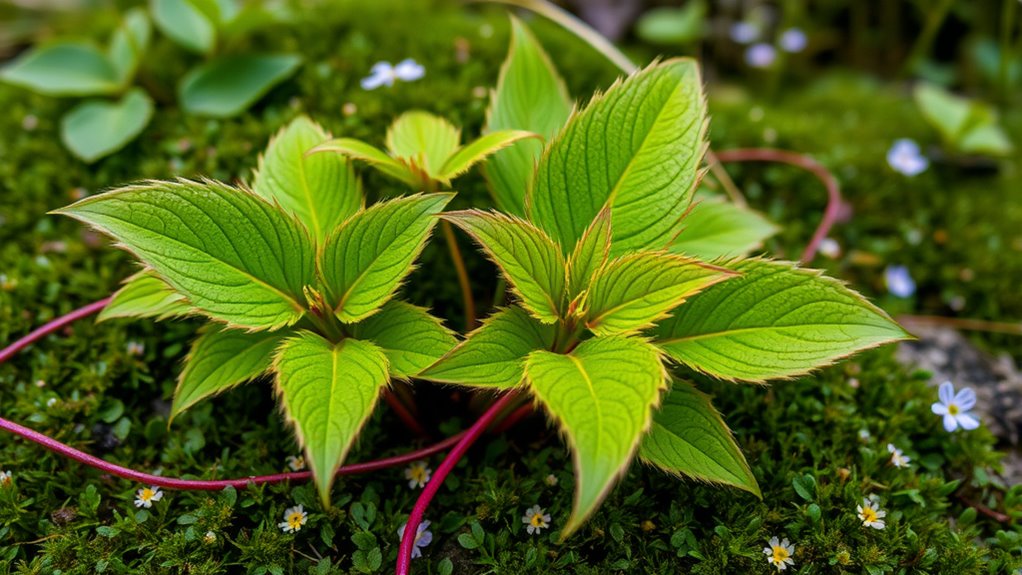
To recognize Sheep Sorrel in its natural habitat, start by observing its common growing environments. It thrives in disturbed areas like meadows, fields, and along shores, often on acidic, sandy soils.
You’ll notice it as an herbaceous, flowering plant with a non-woody, low-growing habit. Its leaves are typically linear to lance-shaped, lacking teeth on the blade, and are arranged alternately on the stem. The plant morphology helps distinguish it from similar species. Additionally, its ability to grow in acidic soils makes it adaptable to various disturbed environments.
The plant has tubular, hollow stipules and produces small flowers with green to brown petals. Sheep Sorrel usually lacks a distinct odor and prefers well-drained or slightly moist soil conditions. Symptoms of breast cancer are unrelated to plant identification, but understanding plant health can sometimes involve noticing unusual growths. Recognizing its preferred soil conditions can aid in accurate identification.
Because it adapts easily, it’s often among other introduced weeds and can quickly colonize disturbed sites, making it a common sight in various habitats worldwide. Foraging practices can help you safely identify and sustainably harvest Sheep Sorrel in the wild.
Best Seasons and Locations for Foraging
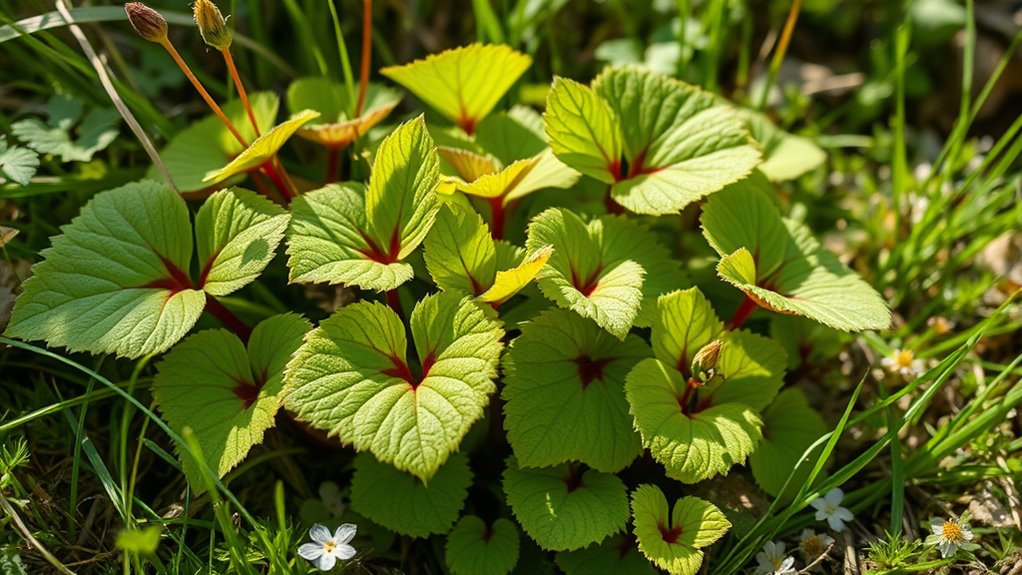
Sheep sorrel is best foraged during spring and early summer when its tender, basal leaves are at their peak quality. In spring, you’ll find these rosette leaves are most flavorful and easy to harvest.
Forage sheep sorrel in spring and early summer for the tastiest, tender basal leaves.
Although sheep sorrel grows year-round, late winter rosettes may appear in some regions, signaling an early start. Summer, especially June and July, offers flowering spikes, but leaves are still available for harvesting.
Ideal locations include gardens with moist, acidic soil, upland moorlands, heathlands, and open sunlit fields with poor soil. Sheltered areas often produce more succulent leaves. Understanding plant growth cycles can help identify the optimal harvest times for sheep sorrel. Recognizing plant growth stages assists foragers in pinpointing the prime harvesting windows. Additionally, awareness of automation in agriculture can inform sustainable harvesting practices. Being familiar with foraging ethics ensures responsible and environmentally friendly harvesting. A thorough knowledge of its growth environment can further enhance successful foraging experiences.
How to Properly Identify Sheep Sorrel
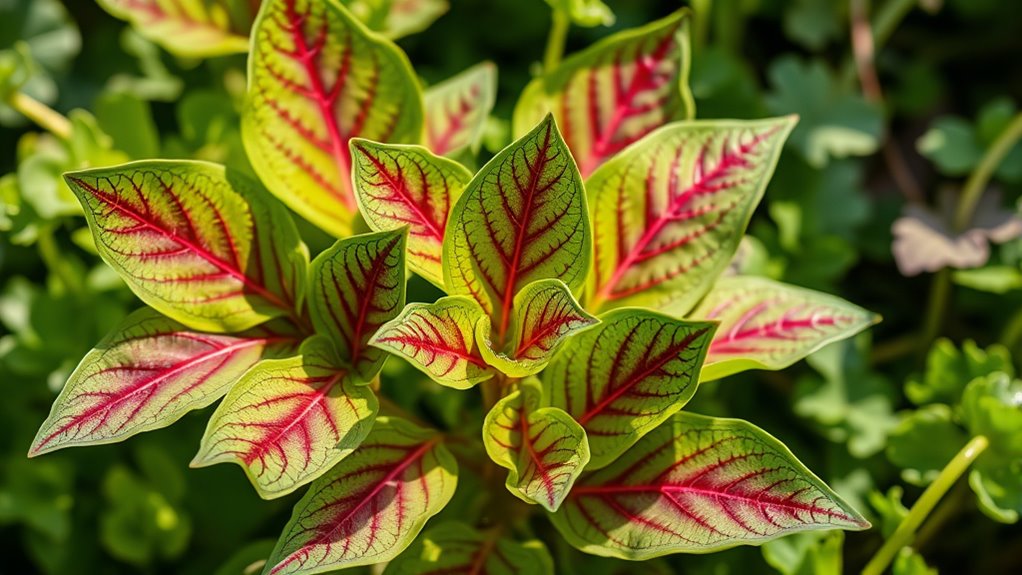
Identifying sheep sorrel accurately is essential for safe foraging, especially since it can resemble other plants. Look for its arrow-shaped or spoon-shaped leaves with flared bottoms that resemble arrowheads. The leaves are typically 1 to 3 inches long and may be green, yellow, or reddish depending on environmental conditions. They grow in a basal rosette, sometimes with leaves along the stem. Herbal tea benefits during flowering, you’ll see small flowers in green, yellow, or red, with two series of tepals—inner tepals are egg-shaped. The flowering stem can grow up to 14 inches tall. Unlike heart-shaped wood sorrel, sheep sorrel’s leaves are more delicate and pointed. Recognizing the plant’s distinctive leaf shape and color helps ensure accurate identification and safe foraging. Being familiar with plant identification techniques can further reduce the risk of confusion with similar species, and understanding plant morphology can aid in distinguishing sheep sorrel from look-alikes.
Harvesting Tips for Tender, Flavorful Leaves
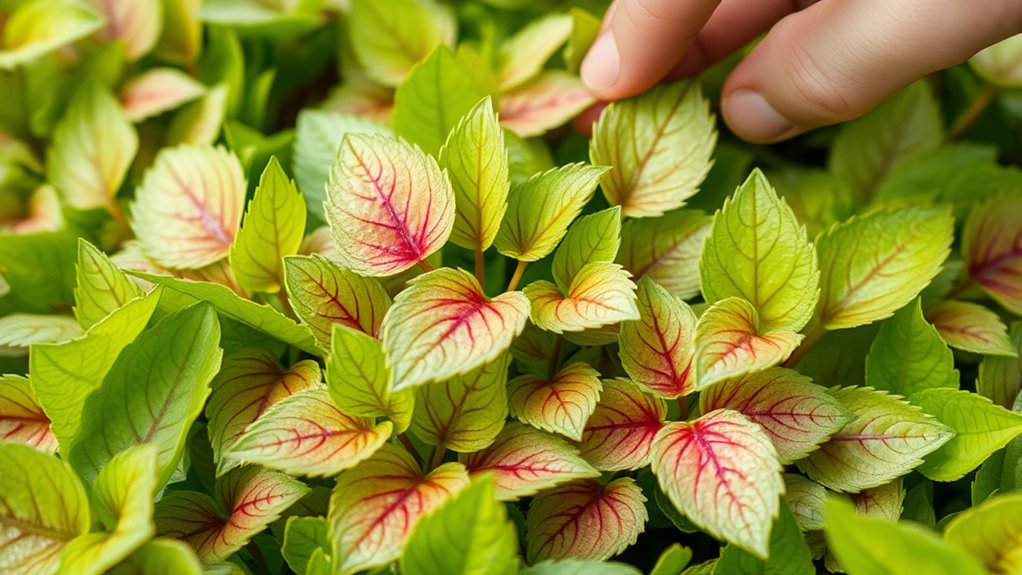
Timing your harvest guarantees you get the most tender and flavorful leaves. Aim to harvest when the plants are about 4 to 5 inches tall during spring to early summer, when they’re young and at their peak flavor. The best time to pick is in the morning, when dew helps preserve moisture and enhances freshness. Use scissors to snip the leafy stems just above a node, encouraging new growth. Focus on harvesting small, tender leaves rather than mature ones for the best taste and texture. Avoid harvesting during hot, drought-stressed periods, as flavor can diminish. Practice the cut-and-come-again method to prolong your harvest, removing flower stalks to promote lush leaf production. Keep your harvest light to sustain healthy, productive plants. Incorporating aesthetic wall organization ideas can help keep your foraging space tidy and inspiring. Additionally, understanding the plant’s growth cycle can optimize your foraging schedule for consistently tender leaves, especially by recognizing the plant’s flowering period, which signals a decline in leaf quality. Being aware of plant health signs can also help you identify the best moments for harvest and avoid damaging stressed or diseased plants. Monitoring environmental factors such as air quality can further support healthy growth and optimal leaf flavor.
Ensuring Safety: Avoiding Poisonous Look-Alikes
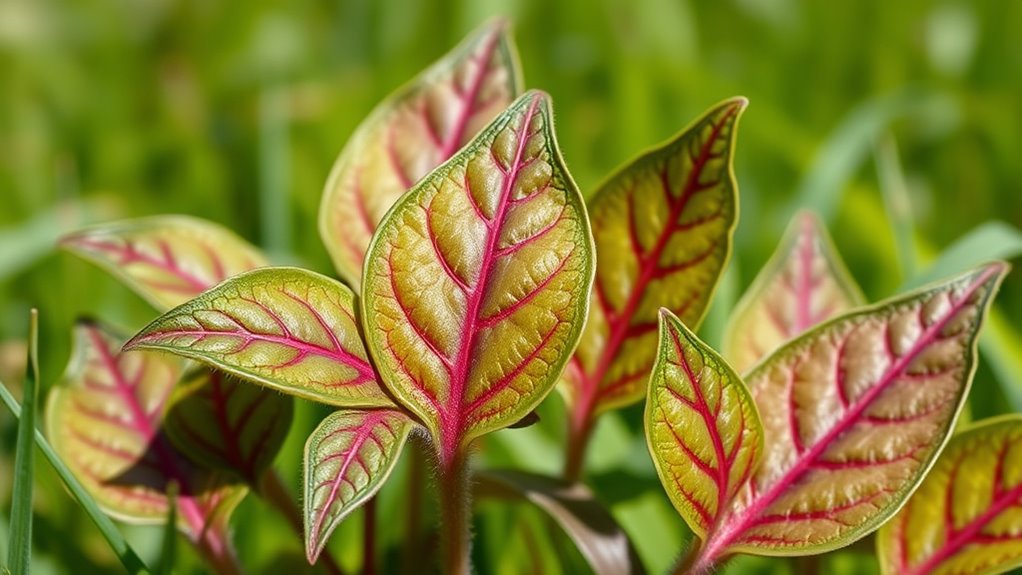
To safely forage sheep sorrel, it’s vital to distinguish it from similar-looking, potentially toxic plants. Sheep sorrel has small, arrow-shaped leaves with a milder tartness than common sorrel. Its tiny green or reddish flowers help identify it, but beware of plants like field bindweed, which shares habitat and leaf shape but is inedible. Educational and Skill-Building Toys like Montessori-inspired matching eggs can help develop identification skills for safe foraging. White-flowered wood sorrel resembles sheep sorrel but lacks the pink or green flowers and has a different flavor profile. Toxic look-alikes include Arum lilies, which can be mistaken for edible sorrels but are poisonous. Always verify plant identity thoroughly before harvesting. Accurate plant identification is crucial to prevent poisoning and ensure safe foraging. Developing plant recognition skills is an essential part of responsible foraging. Starting with a small taste test is advisable, and avoid plants that don’t match the precise leaf shape, flower color, or flavor. Proper ID prevents poisoning and ensures safe foraging. Additionally, understanding the distinctive features of edible versus toxic plants greatly enhances foraging safety. Incorporating visual aids such as photographs or field guides can further improve identification accuracy.
Preparing and Incorporating Sheep Sorrel Into Salads
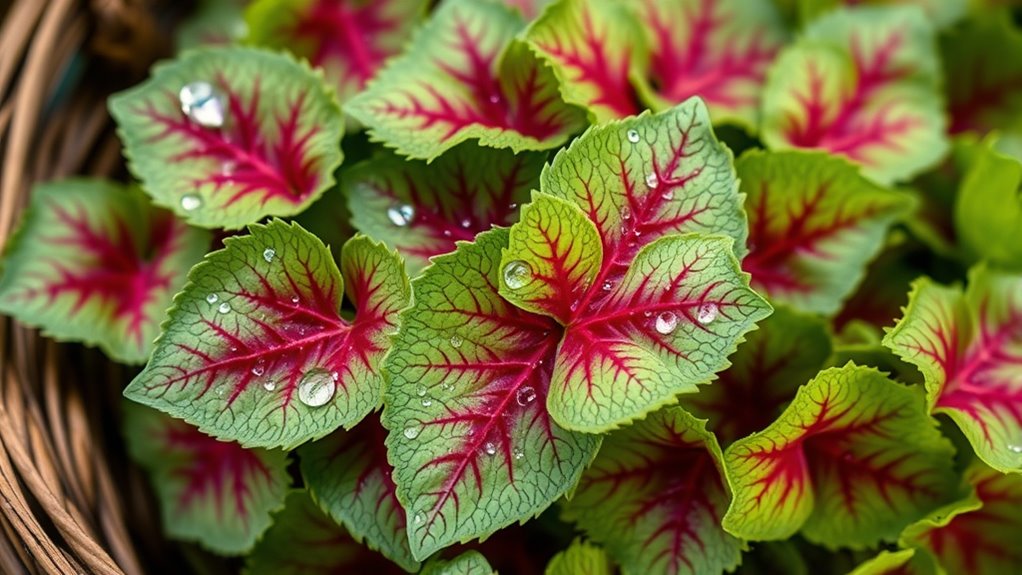
Before adding sheep sorrel to your salad, it’s essential to prepare it properly to guarantee freshness and safety. Start by washing the leaves thoroughly to remove dirt and potential contaminants. Gently dry the leaves with a clean towel or salad spinner to prevent excess moisture, which can make your salad soggy.
If the leaves are large or tough, chop or tear them into smaller, bite-sized pieces for easier eating and better distribution of flavor. Mix sheep sorrel with other greens or herbs to create a balanced flavor profile.
Store the cleaned and dried leaves in an airtight container in the refrigerator to keep them fresh. Proper preparation ensures your salad is safe, vibrant, and delicious every time.
Creative Uses of Sheep Sorrel in Culinary Dishes
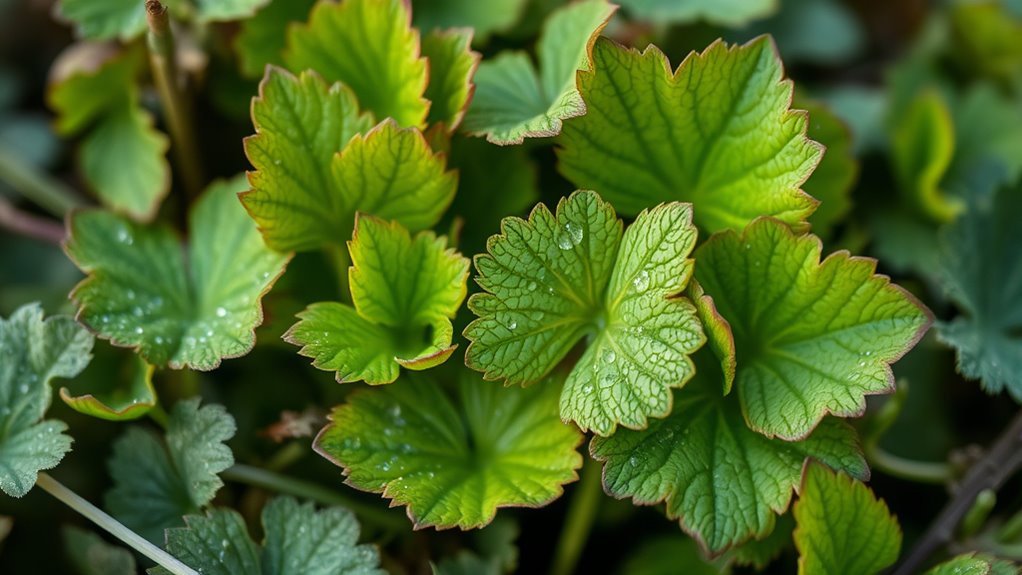
Sheep sorrel’s bright, tangy flavor opens up a variety of creative culinary possibilities beyond traditional salads. You can add it to soups and stews for a fresh, lemon-like acidity that brightens the dish.
Sautéing sheep sorrel with garlic and onions enhances its flavor, making a tasty side or ingredient. It also works well in sauces, especially those paired with fish or meats, adding depth and a tart kick.
For pasta dishes, toss in chopped sheep sorrel for a tangy twist. You can prepare sorrel-infused oils to elevate dressings or create vibrant sauces.
Additionally, blending sheep sorrel into pestos or marinades introduces a lively flavor that complements seafood, vegetables, and vegetarian dishes. Its culinary versatility makes it a valuable ingredient in many creative recipes.
Incorporating sheep sorrel into nutritional benefits can boost the fiber and antioxidants in your meals, enhancing both flavor and health.
Nutritional Benefits of Including Sheep Sorrel
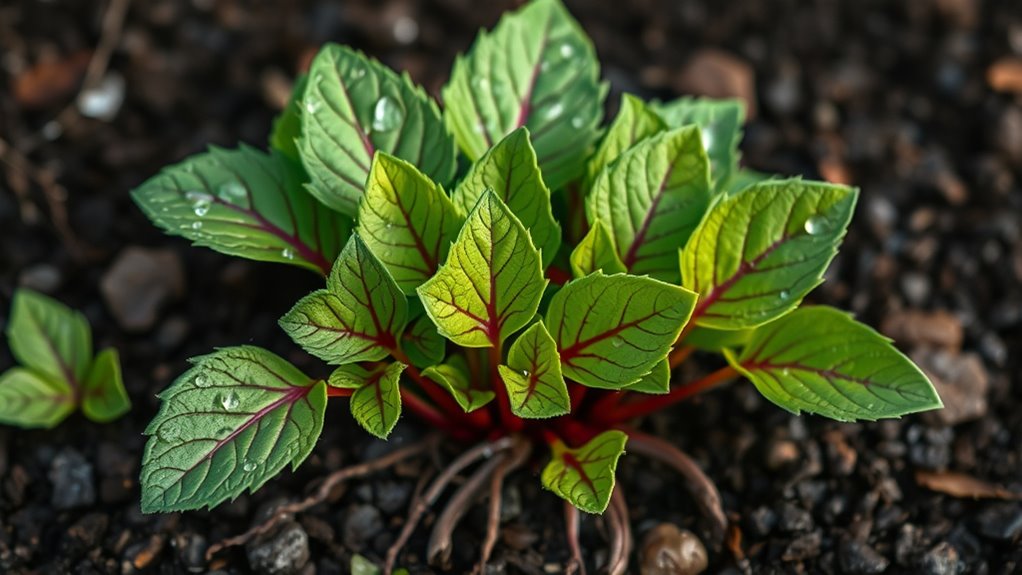
Incorporating sheep sorrel into your diet offers a range of nutritional benefits, making it a smart choice for health-conscious individuals. It’s packed with dietary fiber, which helps improve digestion and keeps you feeling full longer. Vegetable juices can also be a great way to consume sheep sorrel in a refreshing form. With significant amounts of vitamin C, it supports your immune system and helps prevent illnesses like scurvy. The mineral profile includes magnesium and potassium, essential for maintaining heart health and hydration. Sheep sorrel is low in calories, ideal for weight management, and provides a small but valuable amount of protein. Its antioxidants, including flavonoids and phenolic compounds, protect your cells from oxidative damage and may reduce inflammation.
Sustainable Foraging and Ethical Harvesting Practices
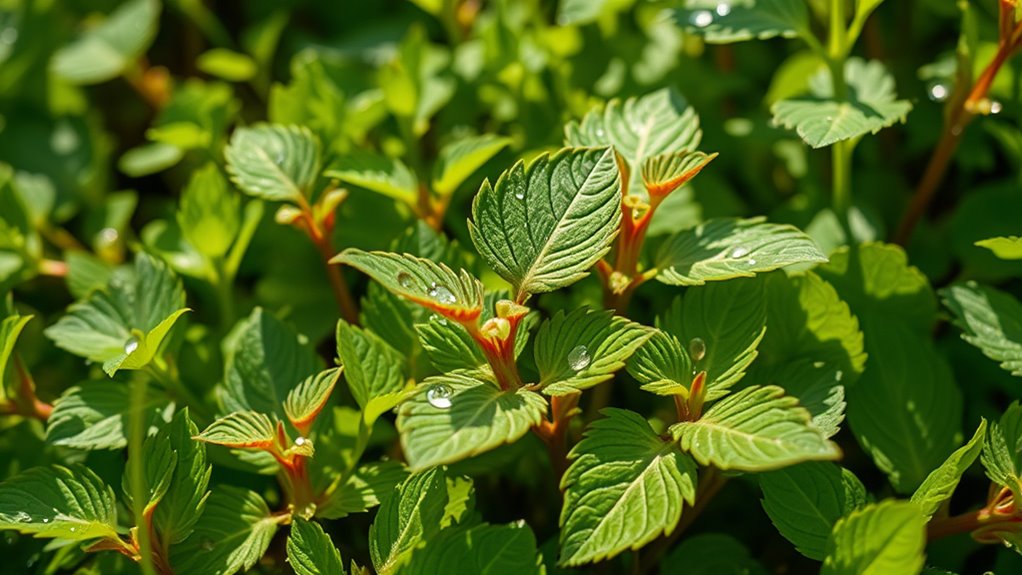
Practicing sustainable foraging and ethical harvesting guarantees you enjoy the benefits of wild plants like sheep sorrel without harming their populations or the environment. Focus on abundant plants with large, widespread populations to avoid depleting rare species.
Harvest only what you need, typically 20% or less, and leave enough plants behind for regeneration. Always identify plants correctly to prevent accidental ingestion of toxic species.
Seek permission before foraging on private land, and avoid removing plants from protected areas like national parks. Be respectful of regulations, limits, and landowners’ rights.
Minimize your impact by avoiding trampling and creating trails. Support native flora by targeting invasive species and leaving some areas untouched.
Share your knowledge and promote responsible foraging to foster a sustainable community.
Frequently Asked Questions
Can Sheep Sorrel Be Cultivated in Home Gardens?
Yes, you can definitely cultivate sheep sorrel in your home garden. It thrives in loose, acidic, well-drained soils and tolerates full sun to partial shade.
To grow it successfully, sow seeds in spring or propagate through roots and rhizomes. Keep the soil moist, prune after flowering, and watch for pests like slugs.
With proper care, you’ll enjoy its tangy leaves for salads and culinary uses.
Are There Any Medicinal Risks Associated With Eating Sheep Sorrel?
You’re asking about medicinal risks from eating sheep sorrel. Consuming it in small, culinary amounts is generally safe, but large quantities can cause health issues like kidney stones, gastrointestinal upset, and electrolyte imbalance due to its oxalic acid content.
If you’re pregnant, breastfeeding, have kidney problems, or take blood thinners, you should be cautious or consult a healthcare professional before including it in your diet.
How Does Sheep Sorrel Compare to Related Edible Plants?
Comparing sheep sorrel to related edible plants, you’ll find that its tangy taste and aggressive growth set it apart. Sheep sorrel has a tart, lemony flavor that enhances salads and sauces, unlike milder wood sorrel or docks.
While all are nutritious, sheep sorrel’s high oxalic acid content demands moderation. Its vigorous, creeping rhizomes make it a hearty, helpful herb, but you should handle it carefully, knowing its powerful, pungent properties.
What Are the Best Storage Methods for Harvested Sheep Sorrel?
You want to know the best ways to store harvested sheep sorrel. For short-term, keep it in a cool, dry place or refrigerate in resealable bags, handling the leaves gently to prevent bruising.
For longer storage, blanch and freeze the leaves in freezer bags or herb cubes, ensuring minimal air. You can also dry and chop the leaves for storage in airtight containers, but freezing preserves flavor and nutrients best.
Can Sheep Sorrel Be Used in Cooked Dishes or Only Raw?
You can definitely use sheep sorrel in cooked dishes, not just raw. Its tangy flavor works well in soups, sauces, and fillings, adding a lemony zest to your recipes.
You might stir it into potato or vegetable soups, or incorporate it into pasta fillings for extra depth. Cooking mellows its acidity slightly, making it a versatile ingredient for both raw and cooked applications, enhancing a variety of dishes with its bright, sour notes.
Conclusion
Imagine your salad bursting with tangy, vibrant leaves of sheep sorrel, their zesty flavor awakening your senses. With careful foraging and mindful harvesting, you can enjoy this wild delight guilt-free, knowing you’re connecting with nature’s bounty. As you toss these tender leaves into your plate, envision the lush green patches and delicate tang that turn simple meals into flavorful adventures. Embrace the harvest, and let sheep sorrel elevate your culinary journey with every bright, invigorating bite.

